Anatomy of the Chest
The chest refers to the two Pectoral muscles, each consisting of a Pectoralis Major and Pectoralis Minor muscle. These muscles are mainly activated during pushing or pressing movements. Typically, each Pectoral muscle is broken down into three regions: the Clavicular, Sternal, and Costal heads. In the figure below, you can see why these heads were given their names. The Clavicular head connects the Humerus (the bone between the elbow and shoulder) to the Clavicle (collar bone). The Sternal head connects the Humerus to the Sternum. And the Costal head connects the Humerus to the Costal Cartilages of the ribs.
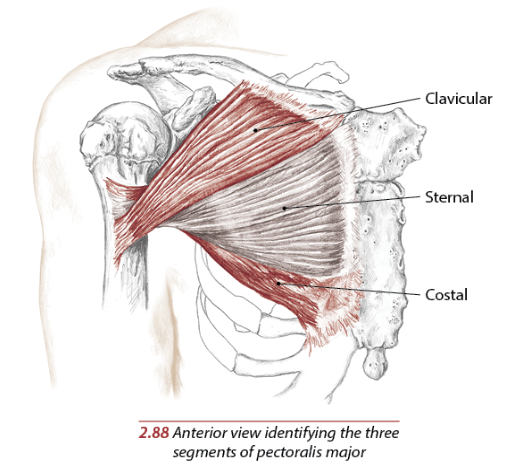
As mentioned, the main movements that activate the Pectoral muscles are pressing or pushing movements such as the Bench Press. Another common movement that activates the chest is the fly, where you squeeze the chest from an elongated position to a closed position. This movement is usually done with a machine, an exercise known as the Machine Fly or Pec Deck.
For all of these movements, the Sternal head is typically the most used since it is the largest and middle-most muscle of the chest. However, we can target the different regions of the chest by changing the angle from which we press or fly. The Sternal head is targeted by pressing with your arms roughly perpendicular to the body. For pushing movements, the bench should be flat, or set to 0 degrees so that the path of the press works directly against gravity, meaning the path is perpendicular to the ground. For flying movements, the same pretty much applies except that you are sitting up instead of lying down - keep your arms perpendicular to the body and squeeze them together around the same angle along the path.
The Clavicular head is usually targeted by pressing at a higher angle. This is done by adjusting the bench from anywhere between 15 and 45 degrees, with the ideal angle being 30 degrees. Although the path should still work directly against gravity, your body is tilted. And due to this angle, you are no longer pressing perpendicular to your body, which causes more emphasis on the Clavicular head. Targeting the Clavicular head with flying movements is a little bit trickier. Instead of maintaining your arms perpendicular to your body, your arms need to move from a lower angle to a higher angle as you perform the exercise. Therefore, cables are typically used for this exercise rather than machines since machines have fixed handles. This exercise is known as Low to High Cable Crossover, or simply Low Cable Crossover.
The Costal head refers to the lower portion of the chest. Oftentimes, it is never targeted specifically because it is also used in Sternal head exercises. Additionally, it is not as impressive visibly or physically as the other parts of the chest. Instead, people try to develop their Clavicular head more since it makes the chest look more round and full. An overdeveloped Costal head will make the chest look saggy. However, there are still many movements that emphasize the Costal head. For pushing movements, the bench is adjusted to a negative angle, which is typically -15 or -10 degrees. Once again, the path is still going to be perpendicular to the ground, but the angle from which you press is not going to be perpendicular to your body due to the change of angle. Additionally, you can target the Costal head with flying movements. When trying to target the Clavicular head, the movement goes from a lower angle to a higher angle. For the Costal head, it is simply the opposite - high to low. This exercise is known as the High Cable Crossover.
Anatomy of the Shoulders
Each shoulder is made up of one primary muscle called the Deltoid. It is a very versatile muscle group due to the various movements of the arm. From here, the Deltoid can be separated into three regions: the Front Deltoid, Lateral Deltoid, and Rear Deltoid. In the figure below, the yellow region represents the Front Deltoid, the red region represents the Lateral Deltoid, and the purple region represents the Rear Deltoid. It should be noted that it is near impossible to target a single region of the Deltoid. Every shoulder exercise will try to target a specific region, but since the Deltoid is a relatively small muscle, it will also utilize the surrounding regions of the targeted region.
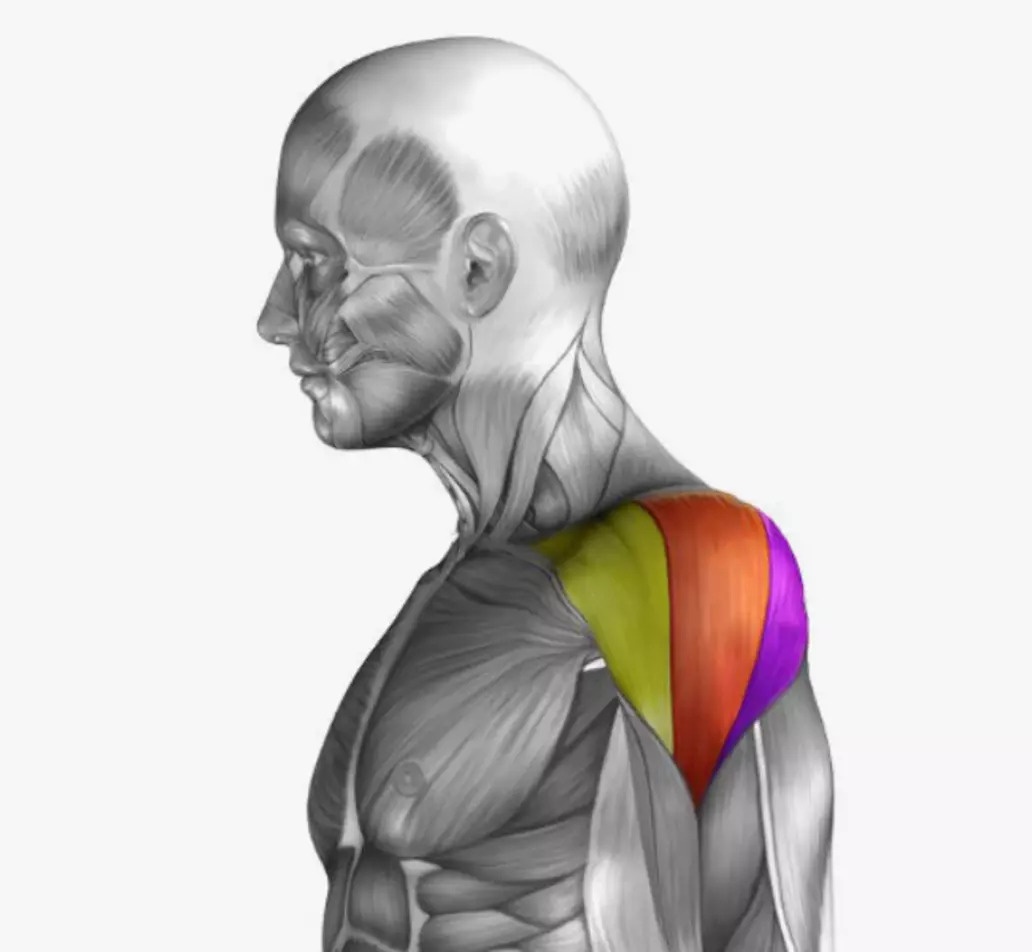
The shoulder is utilized in many movements due to the arm's range of mobility. Though, most shoulder exercises can be classified into three movement groups: the press, raise, and fly, which target the Front, Lateral, and Rear Deltoid respectively.
The Lateral Deltoid is usually targeted through Lateral Raises of any form. This includes dumbbells, machinery, cables, etc. The starting position of any Lateral Raise requires for you to loosen your arms; let them dangle. Then, hold the weight with a slight bend in your arms. Make sure not to contract or extend your arm from this position to maximize shoulder tension. The main movement consists of you raising the weight from the starter position to your side, making your arms parallel to the ground. Pretend you are trying to fly and that your arms are your wings. For my first tip, I would recommend that you control the movement and keep it relatively slow compared to other exercises. The next tip is to act like you are raising the weight with the palm of your hand and not with your fingers. I can guarantee that doing this will make you feel your Lateral Deltoid so much more. This will reduce some unwanted Trapezius usage as well. Note that it takes a lot of time to progress in weight for Lateral Raises. This is normal since the Lateral Deltoid is a small muscle, and we are isolating it.
The Front Deltoid is primarily activated in pressing movements, such as the Shoulder Press. Most Shoulder Press variations will require you to be seated, but some will make you stand like the Overhead Press. From what I've seen, most people use dumbbells, so I would suggest becoming familiar with doing Dumbbell Shoulder Press first. This exercise will require you to balance both dumbbells during the entire movement. As for the form, the most common mistake is spreading your arms too wide. Let's say the starting point is at 0 degrees when your arms are together like you are praying. From here, you want to open each arm around 75 degrees. Going too far will cause you to be more prone to injuries and harming your shoulder joints. During the movement, you want to press in a way such that your forearm maintains the same angle and orientation. In other words, your forearm should move linearly. There is another exercise known as the Front Raise that will also target the Front Deltoid. It is very similar to the Lateral Raise, but instead of raising the weight to the side, we raise it forward or in front as the name suggests.
The final region of the shoulder is often neglected by many. However, giving attention to the Rear Deltoid is essential as it rounds and completes the Deltoid, making it look more full and substantial. This muscle group is usually targeted with flying movements that involve pulling or squeezing your shoulder blades together. Many of these exercises start by having your arms straight and in front of you. Then, you would pull your arms backwards with some resistance, of course. Just like the Lateral Raise, it is crucial to make sure your arms have a slight bend, but neither arm should bend an excessive amount during the exercise. Typically, people target their Rear Deltoids with dumbbells or a machine, but I prefer to use cables. I would suggest that you try them all out to see which one you like most.
Anatomy of the Back
The back consists of many layers, each with many different muscles. When talking about bodybuilding, we typically only mention the most superficial muscles since they are the most visible muscles of the back. These muscles include the Latissimus Dorsi, Trapezius, and many other smaller muscles that are collectively known as the Upper Back. These Upper Back muscles include the Infraspinatus, Teres Major and Minor, Rhomboid Major and Minor, and the lower portion of the Trapezius. In the figure below, you can see all of the different muscles I have listed except for the Rhomboids. This is because they are actually beneath the Trapezius. However, they play an important role for back thickness, so they are often mentioned in the Upper Back.
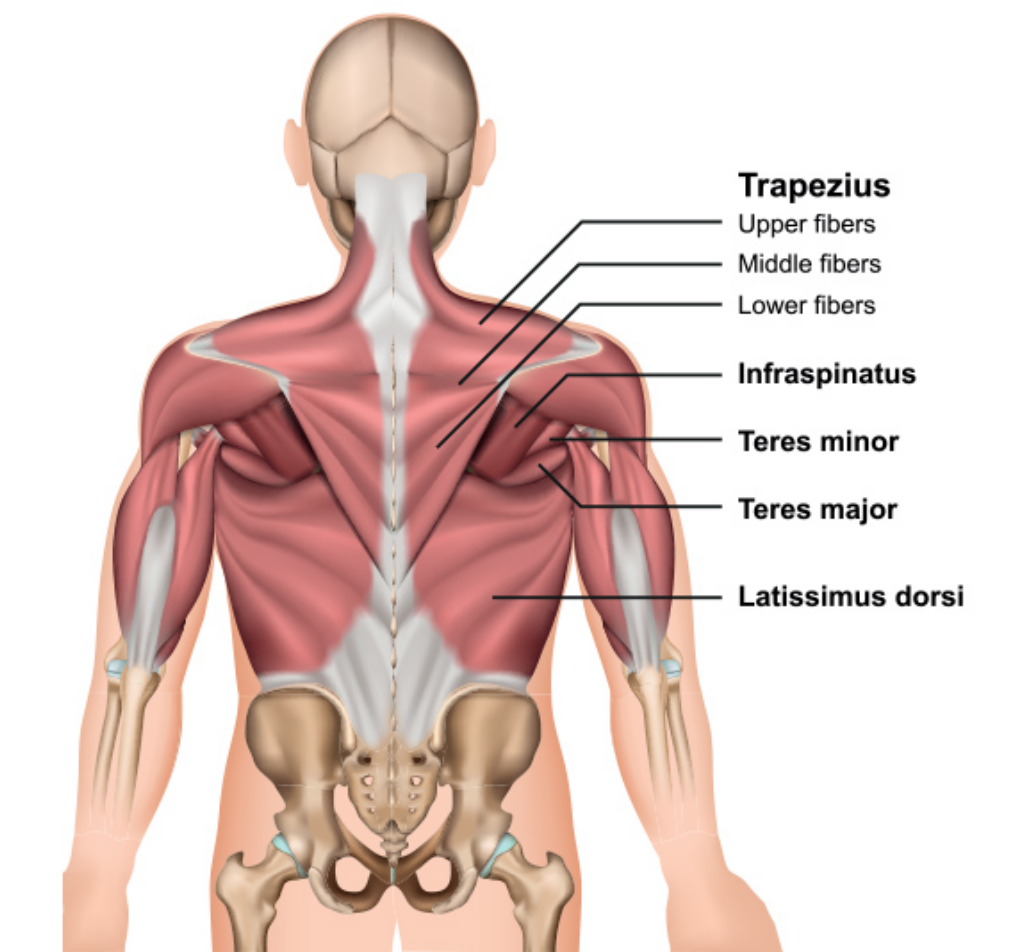
Back exercises are all about pulling. The weight starts from a distance away from you, and you have to bring it to a position that is closer to the body. Most back exercises can be categorized into a row or pulldown. The difference between these two categories is where the weight starts from. A row typically consists of a horizontal pulling movement below the shoulders, as if you were rowing a boat. The pulldown has the weight originate above the head, making the pulling movement much more vertical. This, of course, results in different muscular usage. Rows can pretty much target all three muscles depending on your chosen form. Pulldowns are primarily used to target the Latissimus Dorsi, since it is a larger muscle and needs more attention.
The Latissimus Dorsi refers to the two large muscles that span both sides of the lower to middle back. I will refer to these muscles in their shorthand, lats. In my opinion, this is the most important muscle to develop in order to gain width and visible size in your posture. As mentioned previously, the pulldown is the primary movement for the lats. There are many variations of the pulldown, but they all are essentially the same thing. The movement starts from a position with stretched and extended arms. Then, you initiate the movement by pulling your arms towards your body. A common tip when doing pulldowns is to act like you are pulling with your elbows, not your arms. You should also pull in such a way that your forearms maintain the same angle and orientation during the entire movement. Just like the tip I gave for the shoulder press, this means that your forearms should move linearly. A tip that helps with that is to act like you are pulling your elbows towards your pockets. Also note that for these exercises, you want to focus on the range of motion and the contraction at the peak of the exercise, when your arms are the closest to the body. And finally, a common mistake people make is pulling the bar too low. This loses tension on the lats. Instead, pull the bar to the upper to middle region of your chest.
When it comes to targeting the Upper Back, the main movement used is the row. The movement for the row is very similar to the pulldown. Your arms will start outstretched, now in front of you instead of above your head. Then, everything else is pretty much the same, including most of the tips. However, instead of pulling vertically, the row involves a horizontal pulling movement. Therefore, instead of acting like you are pulling your elbows to your pockets, imagine that you are trying to touch your elbows behind your back. And pull the bar to your abdomen, not your chest. This should be all of the minute differences in the tips between the pulldown and row.
The Trapezius is used in a multitude of exercises that are not limited to just the back. This includes Lateral Raises and even Deadlifts. However, if we want to isolate the Trapezius, there are a few exercises we can do. These exercises are little different than a pulldown or row, but they maintain the same pulling principle. They involve moving the shoulder up and down or front and back. The exercises I have included for the Trapezius include the Shrug, Upright Row, and Face Pull. Though, it should be noted that the Trapezius is not a frequent muscle that is trained in isolation amongst gym goers since it is used in many other exercises already.
Anatomy of the Arms
The arms are essential for us humans to function the way we do. Each arm can be broken down into three muscle groups: the Bicep, Tricep, and Forearm. To dive deeper, each muscle group can be divided even further. The Bicep has a long and short head, and the Brachialis is also usually considered when talking about the Bicep. The Tricep is composed of three regions known as the long, lateral, and medial heads. Finally, the Forearm is made of many smaller muscles, so much that they are categorized into two groups known as the Extensors and Flexors. Extensors lie on the outside of the forearm while Flexors are found on the inside of the forearm. The most notable muscle of the Forearm is the Brachioradialis. In the figure below, the left side shows the inside view of the arm with the palm facing outwards, and the right side shows the exact opposite view. However, the image is a bit too detailed for us due to how I categorize the arm muscles.
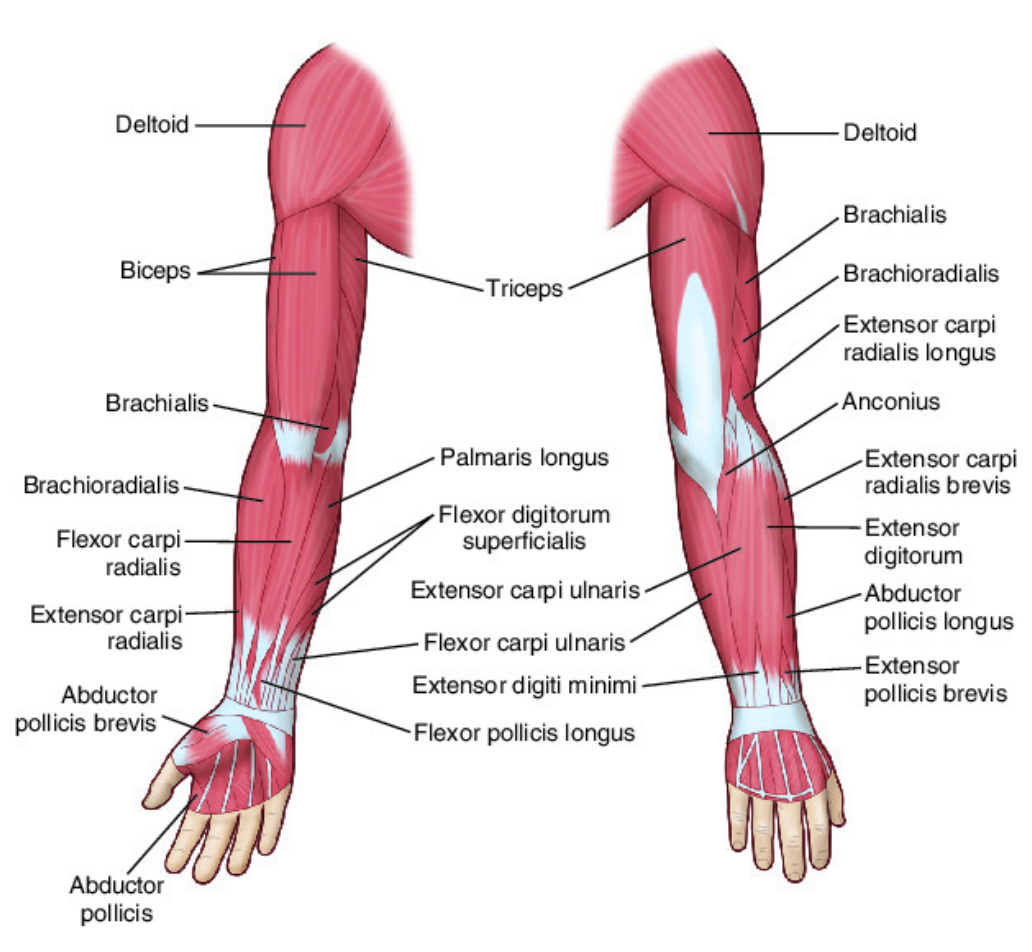
The upper limbs of the human body can do many things that are vital for our performance, and their muscles are critical for their movement. For one, the Biceps control the contraction and flexion movements of the arm, which are also known as curls. Extension movements are done by the Tricep. And the Forearm allows us to not only grip and hold things, but also move the hand in various ways around the wrist. The muscles in the Forearm can also be targeted through curls, but they are quite different than those curls that target the Bicep.
Curls are all you hear for Biceps. And curls are all you really need. To be frank, that's all there is. I would just suggest trying out various curl exercises, so you can choose the ones that best suits you. Though, if you care enough, the long head of the Bicep is targeted more with a wider grip, curling more outward. Whereas the short head of the Bicep is emphasized with a closer grip, curling more inward. The only tip I have is to make sure you are not moving your elbows very much as this takes some focus away from the Bicep.
The Triceps are activated through movements that extend your arm, simply known as extensions. This is clearly just the opposite movement of a curl. It is a bit hard to target a specific head of the Tricep. Instead, I would just focus on training hard, and the Tricep should develop as a whole. The tip for the Biceps also applies here; try not to move your elbows too much as that shifts emphasis off the Triceps. Other than that, there's not much else to say. Train with intensity, and you will see progress.
The Forearms are often neglected. They are not as popular to train when compared to the Biceps or Triceps, but they are still very important to develop. We use them every day to grasp objects and hold onto physical entities. The main way to train your Forearms is to train your grip strength. This is done by holding onto a weight for a duration of time, which is actually done in many other exercises, such as the row, pulldown, and deadlift. Another way to train your Forearms is with wrist flexion and extension movements, which are known as Wrist Curls.
Anatomy of the Legs
The lower extremities of the human body are quite complex as they provide a strong foundation for movement and gait. Typically, each leg can be broken down into four main regions of muscle. These include the Quadriceps, Hamstrings, Glutes, and Calves. Each of these groups is made up of a multitude of muscles that I will not go into further detail since there are too many. For the most part, the leg muscles can be compared to the arm muscles. The Quadricep of the legs is very much like the Tricep of the arm, both of which are used for the extension of the limb. The Hamstring is much like the Bicep of the arm, for flexion of the limb. The Calf usually refers to the back side of the lower leg, but there are also many muscles in the Shin or Tibia, which is the front part of the lower leg. However, the Tibia muscles are rarely ever mentioned in a general weightlifting scenario. The Calf muslces ar similar to the Flexors of the Forearm, and the Shin muslces are like the Extensors of the Forearm. Lastly, the Glutes serve a bigger purpose, but they have some similarities to the shoulders and chest for the arms.
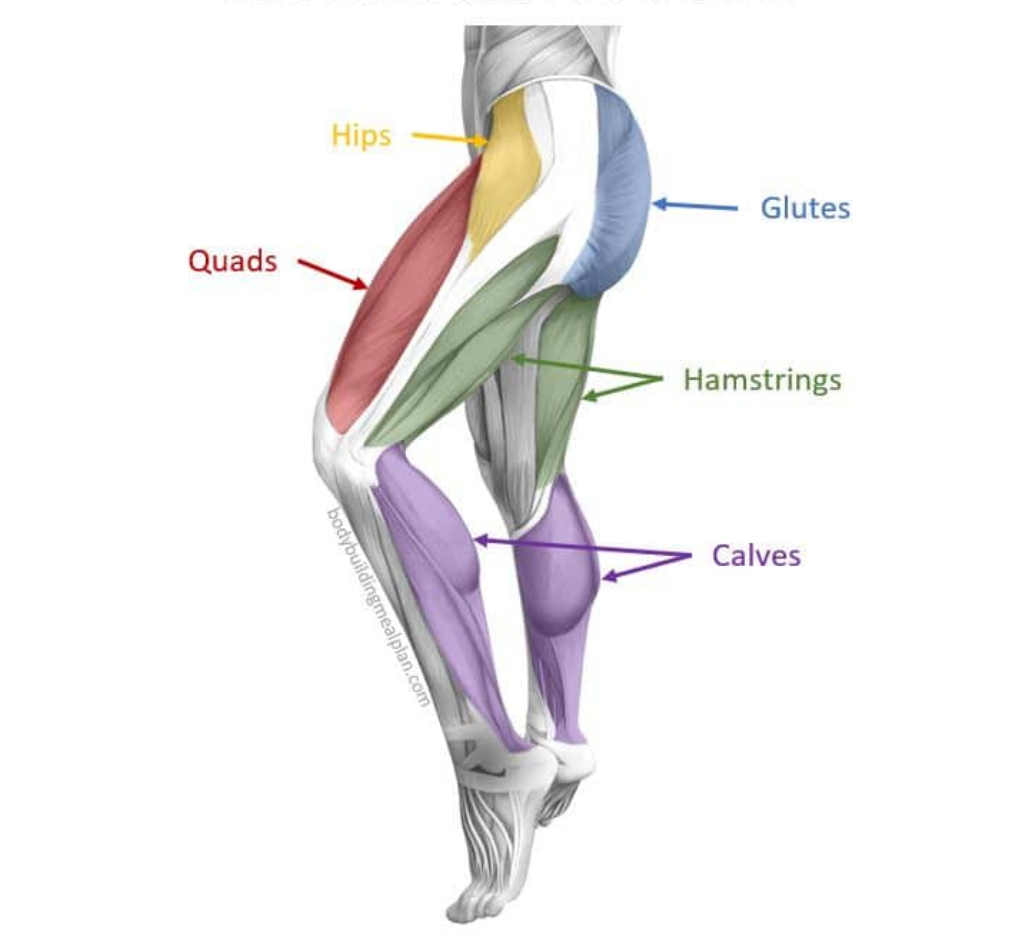
There are many varying exercises that target the different regions of the legs. It is a bit hard to generalize them, and some exercises like the Deadlift utilize multiple muscular regions of the leg. The Squat may also be used to target multiple muscles. But for the most part, Squats are used to target the Quadricep, whereas the Deadlift targets both the Hamstrings and Glutes. Finally, the Calves are utilized in their own separate movement simply known as the Calf Raise.
I want to first talk about the Glutes. They are used for stabilizing the body in all lower body physical activities. Whenever we walk or stand up, the Glutes play a key role in our balance. However, targeting the Glutes can be a bit odd and tricky. The exercises that target the Glutes may seem unrelated, but they have similarities that include balancing the body. The only exercise that specifically targets the Glutes is the Hip Thrust. Other exercises that will activate the Glutes typically utilize other muscles as well, such as the Quadricep and Hamstring. The Lower Back, or more specifically, the Erector Spinae may also be used a considerable amount.
The Hamstrings are targeted by the Deadlift or a Leg Curl. To begin, the Leg Curl is very similar to a Bicep Curl, but it just uses the legs instead of the arms. Since our legs cannot hold onto dumbbells or a barbell, a machine is used to do a Leg Curl. Note that this exercise will isolate the Hamstring from the other leg muscles. Moving on, the Deadlift is a renowned exercise, usually listed in the big 3 exercises: the Bench, Squat, and Deadlift. However, it is not the best exercise from a bodybuilding standpoint. The Deadlift is too widespread in terms of muscular usage and is mainly done for fun or powerlifing. Otherwise, there are many variations of the Deadlift that will target the Hamstrings and Glutes much better. Specifically, the Romanian Deadlift is the most common variation. In any case, regardless of the variation, Deadlifts require you to perfect your form to minimize injuries, which can be life-altering. There are general guidelines that you must follow, such as keeping a straight back, but I think the only real way to perfect your form is to do the exercise and gain experience with it, like most other exercises.
Next, the Quadriceps are used to extend the leg and are primarily targeted in a squatting movement. However, Squats can also target the Glutes and even the Hamstrings at times. In any matter, Squats are essential for Quadricep development. I would suggest trying out various squat exercises to see which one you like best. The Barbell Squat and Hack Squat are by far the most popular, and rightfully so. There are two other exercises I would like to mention. Firstly, the Leg Press mimics the squatting motion but in a seated position. Although this exercise may seem like it can replace the squat, it cannot. Instead, it is seen as sort of an auxillary exercise for the Quadriceps. You cannot replace the squat; it is essential for all leg workouts. The other exercise is the Leg Extension, which isolates the Quadricep. Much like the Leg Curl, it is hard for us to hold weight with our legs, and we must therefore use a machine for this exercise once again.
Finally, the Calves are targeted by their own movement, separated from the other leg exercises. This movement, the Calf Raise, simply consists of you extending your feet like how people tip toe. From here, there are many different ways we can add weight, but they are all essentially the same. You want to keep the movement controlled and slow to ensure that the Calves are kept under tension. One tip to develop your Calves further is to hold or pause momentarily at the peak of the movement. However, it is very common to hear complaints about Calf growth. A lot of people struggle to grow their Calves even though they are moving up in weight for the exercise. Simply put, the size of your Calves is greatly influenced by your genetics, but if you train hard enough, you should see at least some growth. Genetics play a major role to every muscle in our body and their sizes, but it just so happens that the Calves are more noticeable and oftentime more visible to others.